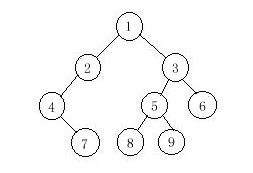本文主要是介绍hdu1710 Binary Tree Traversals ----- 二叉树前序中序推后序,希望对大家解决编程问题提供一定的参考价值,需要的开发者们随着小编来一起学习吧!
原题链接: http://acm.hdu.edu.cn/showproblem.php?pid=1710
一:原题内容
In a preorder traversal of the vertices of T, we visit the root r followed by visiting the vertices of T1 in preorder, then the vertices of T2 in preorder.
In an inorder traversal of the vertices of T, we visit the vertices of T1 in inorder, then the root r, followed by the vertices of T2 in inorder.
In a postorder traversal of the vertices of T, we visit the vertices of T1 in postorder, then the vertices of T2 in postorder and finally we visit r.
Now you are given the preorder sequence and inorder sequence of a certain binary tree. Try to find out its postorder sequence.

9 1 2 4 7 3 5 8 9 6 4 7 2 1 8 5 9 3 6
7 4 2 8 9 5 6 3 1
二:分析理解
题意:根据前序和中序写出后序 前序:1 2 4 7 3 5 8 9 6 中序:4 7 2 1 8 5 9 3 6 求出后序:7 4 2 8 9 5 6 3 1
首先得知道是如何前序遍历、中序遍历、后序遍历的,自己上网查下,我在这里就不多说了
思路:第一步:根据前序可知根节点为1;第二步:根据中序可知4 7 2为根节点1的左子树和8 5 9 3 6为根节点1的右子树;第三步:递归实现,把4 7 2当做新的一棵树和8 5 9 3 6也当做新的一棵树;第四步:在递归的过程中输出后序。
三:AC代码
#define _CRT_SECURE_NO_DEPRECATE
#define _CRT_SECURE_CPP_OVERLOAD_STANDARD_NAMES 1 #include<iostream>
#include<algorithm>using namespace std;int t1[1005];
int t2[1005];void Func(int a, int b, int n, int flag)
{if (n == 1){printf("%d ", t1[a]);return;}else if (n == 0)return;int i = 0;for (; t1[a] != t2[b + i]; i++);Func(a + 1, b, i, 0);Func(a + i + 1, b + i + 1, n - i - 1, 0);if (flag == 1)printf("%d", t1[a]);elseprintf("%d ", t1[a]);
}int main()
{int n;while (~scanf("%d", &n)){for (int i = 1; i <= n; i++)scanf("%d", &t1[i]);for (int i = 1; i <= n; i++)scanf("%d", &t2[i]);Func(1, 1, n, 1);printf("\n");}return 0;
}
#define _CRT_SECURE_NO_DEPRECATE
#define _CRT_SECURE_CPP_OVERLOAD_STANDARD_NAMES 1 #include<iostream>
#include<algorithm> using namespace std;struct Node
{int data;Node* pLeft;Node* pRight;Node(int _data) :data(_data) { pLeft = pRight = nullptr; }
};Node* root;
int N;
int a[1005];
int b[1005];Node* create(int t1,int t2,int num)
{Node* p = nullptr;for (int i = 0; i <num; i++){if (a[t1] == b[t2+i]){p = new Node(a[t1]);p->pLeft = create(t1+1,t2,i);p->pRight = create(t1 + i + 1, t2 + i + 1, num - i - 1);return p;}}return p;
}void postOrder(Node* p)
{if (p == nullptr)return;else{postOrder(p->pLeft);postOrder(p->pRight);if (p == root)printf("%d\n", p->data);elseprintf("%d ", p->data);}
}int main()
{while (~scanf("%d", &N)){for (int i = 0; i < N; i++)scanf("%d", &a[i]);for (int i = 0; i < N; i++)scanf("%d", &b[i]);root = create(0, 0, N);postOrder(root);}return 0;
}
参考博客链接: http://www.cnblogs.com/jiangjing/archive/2013/01/14/2860163.html
这篇关于hdu1710 Binary Tree Traversals ----- 二叉树前序中序推后序的文章就介绍到这儿,希望我们推荐的文章对编程师们有所帮助!





![笔试强训,[NOIP2002普及组]过河卒牛客.游游的水果大礼包牛客.买卖股票的最好时机(二)二叉树非递归前序遍历](https://i-blog.csdnimg.cn/direct/17efc4d0a1b749cb89ebdd715e23402b.png)
